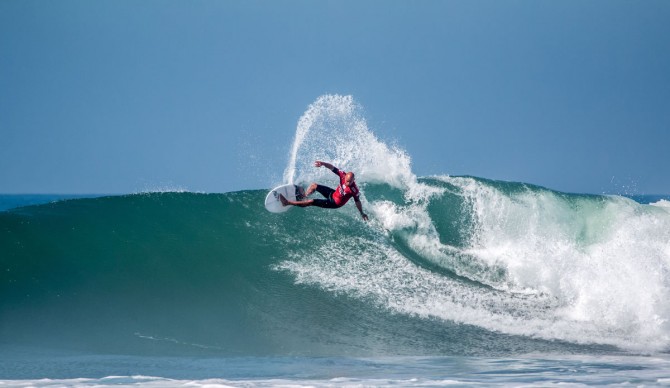Editor’s Note: If you’re interested in more surf-centric workout programs designed to improve your wave count and your health, check out Boost Your Surf Training with Gershon Borlai.

Kelly, executing great mechanics for a proper turn.
Surfing requires a tremendous amount of upper body flexibility and mobility in order to turn or complete extraordinary maneuvers on an open wave face. With this easy stretching drill, you can prepare your spine for a radical turn in the pocket without worrying too much about getting injured or straining your muscle tissue.
So, how does this side-lying windmill movement improve your surfing? Well, turns start from the head and continue through the shoulders, eventually onto the rest of the body and moving down to the board itself. Your thoracic spine is in the middle of your back, from the base of the neck to the area between your shoulder blades. Good mobility in the thoracic spine allows you to move your arms freely over your head and turn side to side.
Poor mobility can lead to shoulder pain and problems, poor posture, and upper back pain. Over time poor posture can take a toll on your spine. Reducing mobility and limiting your ability to use your body freely during surfing.
People with a frozen upper back ( T-spine) often just end up compensating from the lower back. And sooner or later, this body compensation will cause some pain.
Proper form for the side lying windmill
To perform the true thoracic spine stretch, you want to turn your shoulders/chest line compared to the hip line and knees. You should feel it in your abs, chest, shoulder and around the scapula.
Proper form is everything. Be specific about how you stretch. Most people don’t stretch, they just try to look like they are stretching.
-lie on your side.
-put your legs on the top of each other, close your knees.
-keep your arms straight, palms facing each other.
-reach forward with the arms on the top.
-imagine that your head is the center of the circle.
-move your arms around your head (reaching with the arm is necessary).
-try to keep your arm close to the ground.
-eyes and head should follow your palms.
-don’t let the knees lift up from the ground.
-take a deep breath in the starting position and exhale during the movement.
Avoid common mistakes
-Keep those knees closed and on the ground. Turning with the arm and upper body may lift your
knees from the ground because of the lack of flexibility in the hip torso and shoulder complex.
Make sure to keep them glued to the ground during turning.
-Your upper body needs to stay relaxed. Stretching is all about relaxing the body parts. Don’t rush
anything. Your body needs time to melt like a candle.
-Keep your breathing rhythm. Take a deep breath through the nose into the belly and exhale through the mouth slowly and consistently as you would inflate a balloon.
If you are interested in more, I have a quick, 5-minute stretch routine that can improve your surfing, you can download the above routine as a 1-page cheat sheet that will help you to stretch the key areas for surfing in 5 minutes at home.
Yours,
Editor’s Note: If you’re interested in more surf-centric workout programs designed to improve your wave count and your health, check out Boost Your Surf Training with Gershon Borlai.

